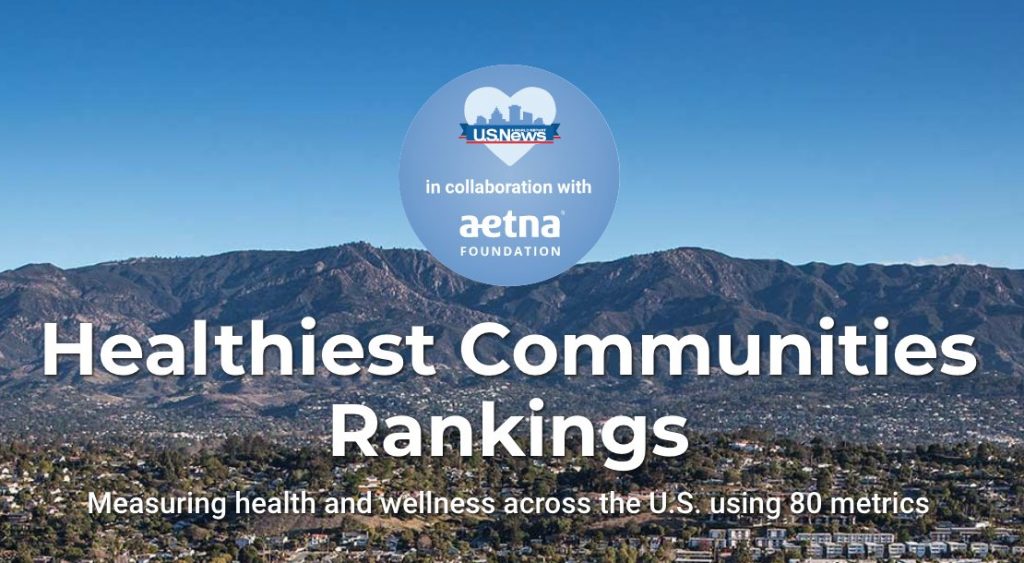 Be the change you wish to see in the world, Gandhi has been attributed as saying. This sentiment was echoed by Lauren Singer as we brainstormed the social determinants of health and the factors that underpin healthy communities.
Be the change you wish to see in the world, Gandhi has been attributed as saying. This sentiment was echoed by Lauren Singer as we brainstormed the social determinants of health and the factors that underpin healthy communities.
Our Facebook Live session was convened by the Aetna Foundation, which sponsored research on the Healthiest Communities in 2018. In addition to Lauren, founder of Trash Is For Tossers, Dr. Garth Graham, President of the Aetna Foundation, Dr. Pedro Noguera, Distinguished Professor of Education at UCLA, and I joined the quartet, moderated with panache and sensitivity by Mark J. Ellwood, journalist.
Each of us four participants came to the conversation with a point-of-view:
- Lauren is a zero-waste advocate, sharing knowledge and hacks about how to simplify life to reduce personal, physical, and financial friction, and simply ask, “what makes you happy?” on a daily basis – then live that authentic life.
- Garth, a board-certified physician in internal medicine and cardiologist by training, is a long-time researcher on health equity and disparities that compromise public and personal health.
- Pedro’s life work as a sociologist has been in education’s role for enriching peoples’ lives, and how schools are influenced by social and economic conditions as well as by demographic trends in local, regional and global contexts.
My own lens as a health economist informs my view that health is shaped where we live, work, play, pray, learn, and shop – in our communities. We each have the opportunity to make health — but too often our ZIP code and neighborhood prevents us from doing so relative to the quality of schools, access to healthy food, air and environmental quality, and limits on our ability to “walk with our feet” and find healthy opportunities each day.
Some of the key points were covered were that:
- Education, from the earliest age, is key to lifelong health and well-being.
- Adverse childhood events (ACEs) can stay with people their whole life long, compromising their ability to learn, get a job, work productively, and self-care for health and healthy relationships.
- Life expectancy can significantly vary in a matter or a few neighborhood blocks, meaning “the difference between living like it’s 2017 or 1917,” Garth recently wrote in U.S. News.
- The research of Christakis and Fowler in their book, Connected, demonstrates that our own behaviors, every single day of our lives, inspire other people in our social circle/network. This then inspires folks in their networks, and so on. That is the viral nature of social networks, so that our own healthy behaviors can initiate a virtuous cycle of health for ourselves, our families, our friends, our work colleagues, and our communities. This is truly being and living out the change for good, for our own health and the health of our communities.
In fact, social connections are at least as powerful as exercise and diet for health, research published in the Proceedings of the National Academy of Sciences has found.
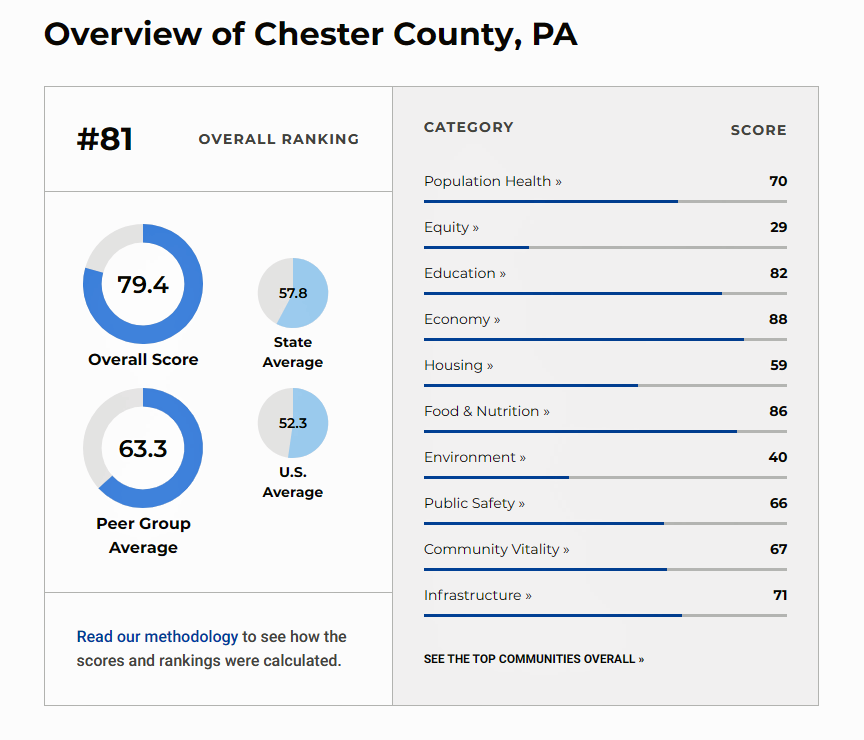 The Healthiest Communities study analyzed a wide range of factors influencing health. I learned that in my region of Chester County, PA, we have many health factor blessings: relatively high life expectancy compared with other U.S. areas and a lower smoking rate. But my home county is also the richest and poorest in the state of Pennsylvania. I sit on board of our town’s free clinic so am aware of our local health challenges based on our own clinic’s patient demographics and my detailed review of our local hospitals’ community assessment reports.
The Healthiest Communities study analyzed a wide range of factors influencing health. I learned that in my region of Chester County, PA, we have many health factor blessings: relatively high life expectancy compared with other U.S. areas and a lower smoking rate. But my home county is also the richest and poorest in the state of Pennsylvania. I sit on board of our town’s free clinic so am aware of our local health challenges based on our own clinic’s patient demographics and my detailed review of our local hospitals’ community assessment reports.
However, the Aetna Foundation study revealed some light-bulb moments that are under the radar in the typical community health assessments: the racial disparity in education in our county is double the national rate, local food sites are less prevalent (which is ironic as we are a heavily agricultural county), we have greater airborne cancer risks, and while the area is relatively walkable, people undergo long commutes.
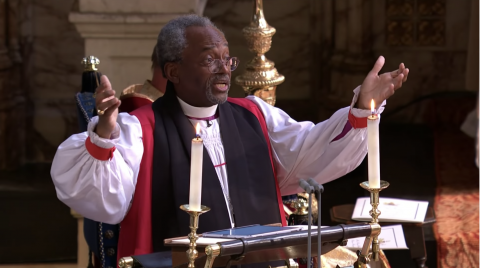 Health Populi’s Hot Points: I was so moved by the Episcopal Church Bishop Michael Curry’s remarks at the wedding of Prince Harry and Meghan Markle this weekend. Here are some snippets from the sermon that resonated with me, especially in the context of social determinants of health and our Healthiest Communities discussion just hours before (Reverend Curry’s words are in italics, and I’ve bold-faced my separations):
Health Populi’s Hot Points: I was so moved by the Episcopal Church Bishop Michael Curry’s remarks at the wedding of Prince Harry and Meghan Markle this weekend. Here are some snippets from the sermon that resonated with me, especially in the context of social determinants of health and our Healthiest Communities discussion just hours before (Reverend Curry’s words are in italics, and I’ve bold-faced my separations):
Quoting Dr. Martin Luther King:
“We must discover the power of love,
the redemptive power of love.
And when we discover that, we will be able to make of this old world
a new world. Love is the only way.”
There’s power in love. Don’t underestimate it. Don’t even over-sentimentalize it. There’s power, power in love. If you don’t believe me, think about a time when you first fell in love. The whole world seemed to center around you, and your beloved. Oh there’s power, power in love. Not just in its romantic forms, but any form, any shape, of love. There’s a certain sense, in which when you are loved, and you know it, when someone cares for you and you know it, when you love and you show it, it actually feels right. There’s something right about it. And there’s a reason for it.
Later…
There’s power in love.
There’s power in love to help and heal when nothing else can.
There’s power in love to lift up and liberate when nothing else will.
There’s power in love to show us the way to live
Then on the power of love:
I’m talking about some power.
Real power.
Power to change the world.
And if you don’t believe me, well, there were some old slaves in America’s Antebellum South, who explained the dynamic power of love and why it has the power to transform. They explained it this way – they sang a spiritual, even in the midst of their captivity. It’s one that says:
“There is a balm in Gilead”
A healing balm, something that can make things right –
“There is a balm in Gilead
To make the wounded whole
There is a balm in Gilead
To heal the sin-sick soul.”
And finally, channeling John Lennon from his anthem, Imagine…
Think, and imagine.
Well, think and imagine a world where love is the way.
Imagine our homes and families when love is the way.
Imagine neighborhoods and communities when love is the way.
Imagine our governments and nations when love is the way.
Imagine business and commerce when love is the way.
Imagine this tired old world when love is the way.
When love is the way, unselfish, sacrificial, redemptive.
When love is the way, then no child would go to bed hungry in this world ever again.
When love is the way, we will let justice roll down like a mighty stream and righteousness like an ever-flowing brook.
When love is the way, poverty would become history.
When love is the way, the earth will be a sanctuary.
When love is the way, we will lay down our swords and shields down by the riverside
to study war no more.
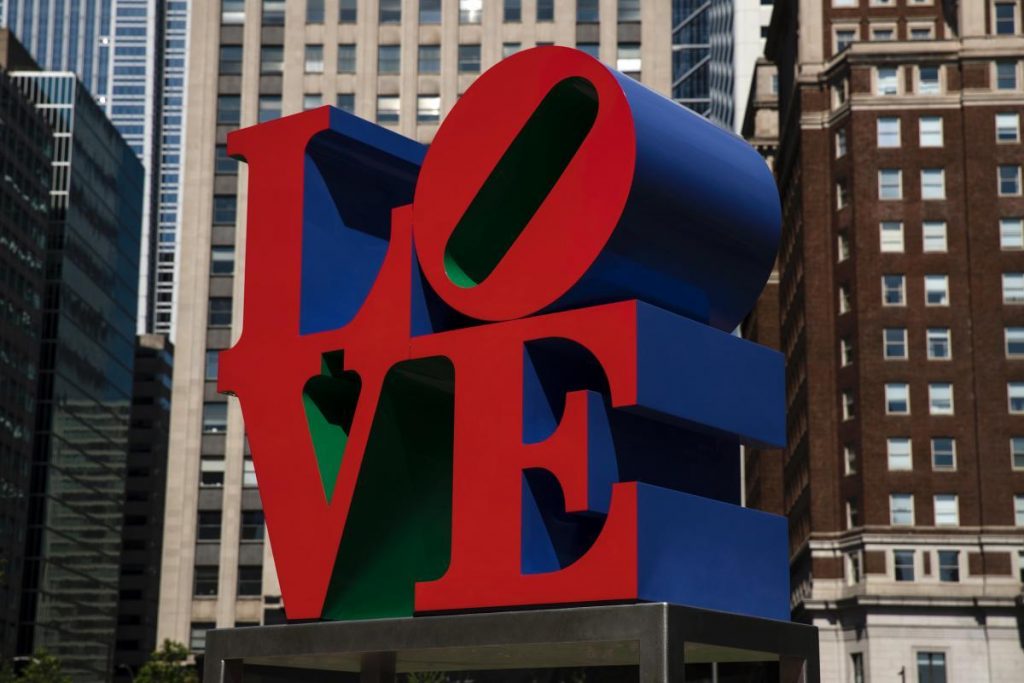 My brothers and sisters, that’s a new heaven, a new earth, a new world.
My brothers and sisters, that’s a new heaven, a new earth, a new world.
A new human family.
So the great and good Reverend Curry was delineating the social determinants of health to inspire all of us.
Or succinctly put by Tim Sanders, #LoveIsTheKillerApp.
A postcript, added on 22nd May – In ironic bittersweet timing, I note the passing of great American artist, Robert Indiana, best-known for his LOVE sculptures featured in gardens and museums all over the world. He passed away earlier this week at the age of 89. The photo here is of his LOVE sculpture located in my Philadelphia town’s John F. Kennedy Plaza, affectionately known by Philadelphia citizens as “Love Park.”


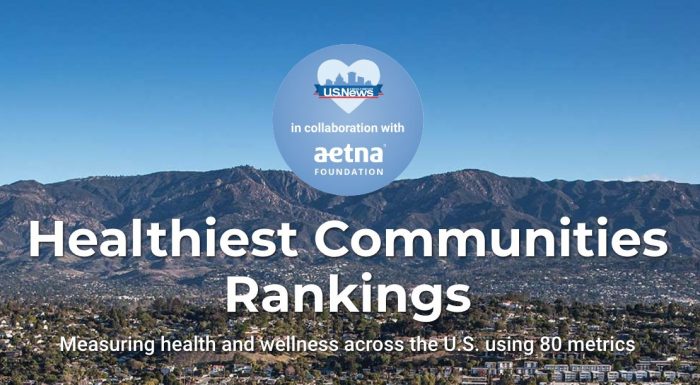


 Interviewed live on BNN Bloomberg (Canada) on the market for GLP-1 drugs for weight loss and their impact on both the health care system and consumer goods and services -- notably, food, nutrition, retail health, gyms, and other sectors.
Interviewed live on BNN Bloomberg (Canada) on the market for GLP-1 drugs for weight loss and their impact on both the health care system and consumer goods and services -- notably, food, nutrition, retail health, gyms, and other sectors. Thank you, Feedspot, for
Thank you, Feedspot, for  As you may know, I have been splitting work- and living-time between the U.S. and the E.U., most recently living in and working from Brussels. In the month of September 2024, I'll be splitting time between London and other parts of the U.K., and Italy where I'll be working with clients on consumer health, self-care and home care focused on food-as-medicine, digital health, business and scenario planning for the future...
As you may know, I have been splitting work- and living-time between the U.S. and the E.U., most recently living in and working from Brussels. In the month of September 2024, I'll be splitting time between London and other parts of the U.K., and Italy where I'll be working with clients on consumer health, self-care and home care focused on food-as-medicine, digital health, business and scenario planning for the future...